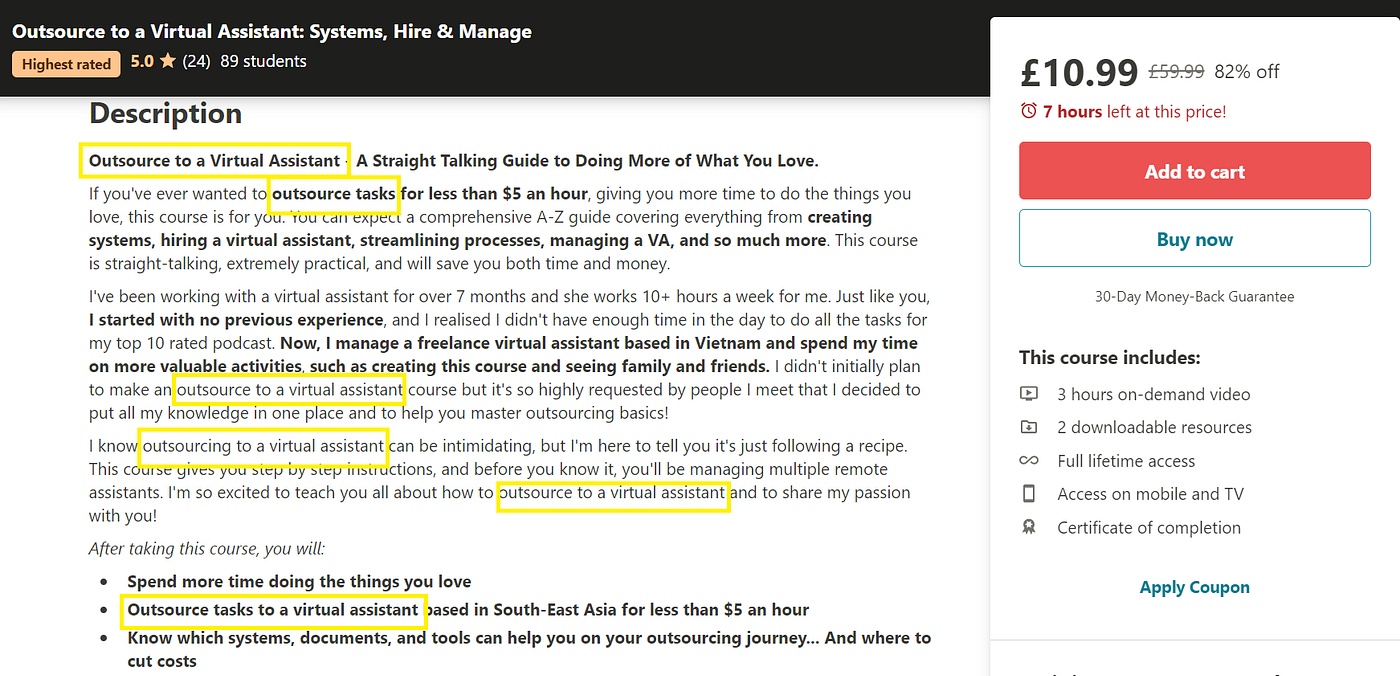How Much Money Do Udemy Instructors Make
How to Make $17,000 a Month in Passive Income from Udemy Courses
One of Udemy's highest-earning teachers laid out her strategy for me
![]()

Let me introduce you to my friend Louise.
She's a digital nomad and serial entrepreneur who, for the last five years, has built a passive income of five figures a month. She also travels around the world with her husband.
Through her Udemy courses and YouTube channel, she's helped over 230,000 students learn new skills, and she's in the process of building an Amazon store.
Last year, I spoke to her for my podcast. I wanted to know how she makes Udemy courses, the lessons she's learned, and how long it's taken her to get to this point.
Following her strategy, I launched my first Udemy course last November. It's made $518.58 to date, with 89 students enrolled.
Here's the strategy she laid out.
1. Why Udemy?
Udemy is like YouTube, but instead of scattered content, teachers structure videos into courses. Many of these courses are priced at $59.99 or above. However, with Udemy's year-round promotions, most sell for $9.99.
Anyone can upload a course, and if it sells, you get half the royalties. Udemy collects the other half in exchange for promoting your course. If you want to market courses yourself, you can use referral links and receive 100% of the profits from each sale.
As Louise pointed out to me, Udemy doing all the marketing is the best and worst thing. Here's why.
Lots of online courses sell for hundreds of dollars, and these are often self-hosted. In other words, the course creator will have their own website, run Facebook ads, and deal with customers. This can bring more stress but potentially a greater reward.
The Udemy model, however, means you might sell courses at a much lower price point, but you also might sell a greater number of them.
"Which option is best depends on what your goals are," says Louise. "Personally, I wanted my course income to be passive, and that's what Udemy gives me. I also want them to be mass market, and I enjoy that my courses are affordable to anyone in the world."
Having created over 40 courses to date, it just so happens Louise gets the best of both worlds: Passive income and lots of it.
2. Identify gaps in the market for things you could teach
Louise started making Udemy courses when she was 23. She moved to Chiang Mai, met a course creator, and figured she could do the same. She already had a camera from her blogging days, and she knew she could teach about fashion, makeup, and lifestyle topics.
Before recording, though, Louise points out topic choice is vital. You have to think about what will people pay for, and what will enough people pay for?
"Many people create a Udemy course without looking at the competition. They'll think about what they could teach, jump behind a camera, and start filming.
It's possible to get lucky, but there's also a chance you could spend days making a course that no one ever sees. That would suck.
Given that you'll make around $3 per sale, and that it could take around 50 hours to make a course, you need to make it worth your while. You also need to consider topics which are less competitive."
Louise recommends searching for existing Udemy courses on your topic and seeing how yours could be different. Could it be shorter or more detailed? Could it look more professional? Could it be targeted at a different audience?
If you can't find a gap in the market, you may have to choose another topic.
3. Start searching keywords on Udemy
It's a good idea to assess which keyword or keywords you could realistically rank for on Udemy.
For example, prior to my outsourcing course, the top-ranking course for the keyword 'outsource to a virtual assistant' had just 19 ratings from 1,742 students. The content also seemed a little fluffy. I knew I could do better.
The best way to find keywords is to do a search on Udemy. I wrote down a list of potential keywords and searched for as many variations as I could think of. Here's a sample:
- outsource to a virtual assistant
- outsource to a va
- outsource
- remote virtual assistant
- freelance virtual assistant
The key is to find keywords that give you an opportunity to make money but aren't overly competitive.
Louise recommends looking for keywords that have less than 1,000 results and around 30 reviews to rank in position one. This way, when you target a keyword, your course is likely to appear at the top of the search results — if not the very top.
4. Choose your primary keyword and plan your course
Once you've identified which keyword you want to target, it's time to plan your course.
I wrote down on paper a list of topics I wanted to cover and put them into five sections. Each section has an introduction to tell students what to expect, and these intros are around two minutes long. The teaching videos are between five and ten minutes.
Louise recommends courses last between two to three hours. If they're shorter than this, there's probably not enough material. Too much longer and students may feel overwhelmed. If this is an issue, you can always break the content down into multiple courses.
It's also important to make sure your course focuses on the primary keyword you want to target. Here are places to include it:
- At the beginning of the course title
- In the course subtitle
- Multiple times throughout the course description
- Say it in the videos themselves
In my course description, I've included the keyword 'outsource to a virtual assistant' multiple times, as well as variations of this, including 'outsource tasks' and 'outsourcing to a virtual assistant'. It sounds natural and I've been careful not to mention it too many times.

Louise has a fantastic Udemy course on how to make a Udemy course which I highly recommend. It goes into more detail about keyword targeting, as well as the specifics of how to record and edit videos.
5. Make a compelling thumbnail and preview video
According to YouTube, thumbnails and titles act like billboards. They help viewers decide which videos to watch.
The same is true for Udemy courses.
There are a few thumbnail rules when it comes to Udemy. Generally, they're not allowed to include text, and it's best to include a human face. These are seen as being more compelling for people to click on.
If in doubt, keep it simple. A picture of you and a few icons can look clean and professional, and Canva has a great background removal tool you can use when you sign up for a pro account.
(Tip: Sign up for a free 30-day trial and cancel before the end of the month.)
With the promotion video, Louise recommends keeping it under two minutes. She also says it should answer the following:
- What is your course about?
- Why should people listen to you? (What's your experience/expertise?)
- What can students expect to learn by taking your course?
- What makes your course different?
- What will be the benefits to students of taking your course?
6. Get those reviews in early
Louise has found getting the ball rolling on reviews is really important for Udemy SEO. Once it's high in the rankings, the quality of your course should start generating these in the coming months and years. For my course, I aimed for 20 in the first two weeks.
Just like when I launched my podcast and got it into the top 10 within 6 days, I was very strategic about asking people in my network to check it out.
On a spreadsheet, I had three columns:
- People in my network who I thought might be interested in my course
- Which platform I messaged them on
- The date I messaged them (so I could follow up a week later)
The message said something like,
"Hey [NAME], hope you're well! I think you might be interested in this course I've created, and using my exclusive discount code, you can get it today for £9.99. If you like what you see, it would be great to see you there!"
If you haven't got many people in your network who you think would be interested, here are a few ways to promote it:
- Create a podcast and interview people who you think might be interested in your course. Here's the kicker, though: Don't mention your course. Once you've developed a connection, reach out a few months later to tell them about it. I didn't launch my podcast with this intention but I was been able to ask guests to check it out. Many did.
- Guest on other podcasts. Bring value to the episode and mention your course at the end as a call to action.
- Line up the launch in relevant Facebook groups. By being an active member of a relevant Facebook group, you can tease your course before its release and tell people about it when it's in the wild.
7. Collaborate with other teachers to create more courses
After creating a number of courses, Louise reached a point where she'd run out of topics.
"I didn't know much about anything, so I decided to collaborate with other teachers."
Here's how she pitched it:
"If you give me a day of your time, I'll do the filming, the editing, the uploading, the writing, the thumbnail — basically everything else.
You can come round to my house, it'll take five hours of your time, there will be unlimited tea and coffee, and you can teach to the camera everything you know about a topic."
With her experience in launching courses, and by splitting the profits 50–50, Louise was offering teachers the chance to earn a passive income whilst also diversifying her courses.
"This is an offer not many can refuse."
8. Cut the excuses
Louise now has just under 32K YouTube subscribers and over 7K followers on Instagram. It wasn't always like this, though, particularly when launching her first few courses.
"You don't need a mailing list, you don't need a big social media presence, and you're not too late."
I agree. Apart from getting feedback from people in my network, I've barely mentioned my course on social media, and it's far exceeded my expectations. There's no greater feeling than earning money whilst you sleep!
Takeaways
I know this strategy works. With Louise's help, I launched my first Udemy course last November, and it's made $518.58 to date, with an average of 10 new students a week. I'm planning on releasing another later this month.
Working during lunch breaks and in the evenings isn't fun, and there's no such thing as money for nothing. However, push through the resistance and the rewards can be high.
My Udemy goal for 2021? Create two new courses a month from February onwards and be making $1,000 a month passive income by the end of July. This isn't quite Louise levels yet, but I'll be on my way!
Louise puts it best:
"There's never been a better time to earn passive income! What's stopping you?"
How Much Money Do Udemy Instructors Make
Source: https://entrepreneurshandbook.co/how-to-make-5-figures-a-month-passive-income-from-udemy-courses-282eca1c290c
Posted by: hardintores1976.blogspot.com

0 Response to "How Much Money Do Udemy Instructors Make"
Post a Comment